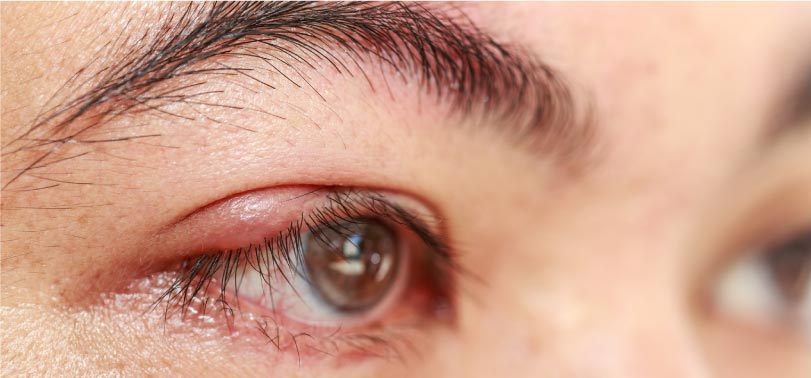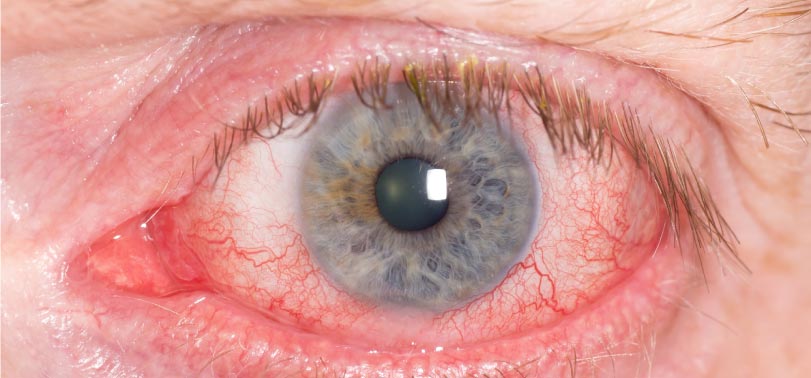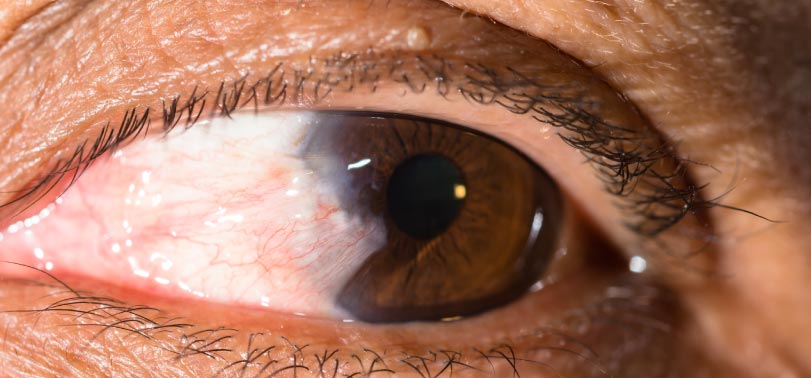


Contact Lens Complications
Contact lens is a medical device prescribed by qualified eye-care professionals to correct your refractive error. However, without proper care and management, it can lead to several complications.
Signs and Symptoms
- Red, irritated, and swollen eyes
- Discomfort and burning sensation
- Gritty and foreign body sensation
- Itchiness and scratchy feeling of the eye
- Dry eyes
- Blurred vision
- Sensitivity towards light
- Watery eyes or eyes with discharges
Among the complications include:
- Allergic reaction – the eyes become red and irritated by the build-up of the protein on the surface of the contact lens. Multipurpose contact lens solution is among the irritants that cause this allergic condition
- Giant papillary conjunctivitis (GPC) – itchy and red prominent bumpiness that appear underneath the eyelid due to contact lens intolerance due to contaminated contact lens that is not replaced frequently
- Contact lens-induced acute red eye (CLARE) – reddening of the eyes due to chronic irritation
- Cornea neovascularization – growth of new blood vessel in the avascular cornea when the eyes become hypoxic (lack of oxygen) due to prolong the wear of contact lens
- Corneal ulcer – the most severe and devastating contact lens complication where the cornea gets infected which subsequently leads to corneal scarring that possibly causes blindness
- Dry eyes
Treatment/Management
-
- Refractive error surgery
- Intense pulsed light (IPL) therapy
- Electromechanical eyelid cleanse therapy
- Lay off contact lens wear
- Proper contact lens care hygiene
- Use glasses prescription



Conjunctivitis (Pink Eye)
Conjunctivitis is an inflammation of the conjunctiva, which is the transparent layer of tissue that covers the white part of our eye. It can be highly contagious and easily spread among family members and friends at school.
Signs and Symptoms
- Pink or red eyes
- Gritty or foreign body sensation of the eyes
- Itchiness or discomfort in one or both eyes
- Swollen eyelids
- Stinging or burning sensation of the eyes
- Increased sensitivity toward light
- Watery or yellow discharge from eyes
- Excessive tearing
- Difficulty opening eyes in the morning upon waking up
Types of Conjunctivitis
- Allergic conjunctivitis – commonly among children and patients who already have an allergic response to environmental or seasonal allergens such as pollen and dust.
- Bacterial conjunctivitis – occurs due to exposure to bacterial infection caused by poor hygiene, improper contact lens care, insects, physical contact with other infected people, contaminated eye makeup, and expired or contaminated facial cream/lotions.
- Viral conjunctivitis – occurs due to exposure to contagious viruses that commonly triggers by coughing and sneezing by other people with respiratory tract infections and the common cold.
Treatment/Management
- Medication eye drops – depending on the types of conjunctivitis
- Artificial tears
- Maintain good personal hygiene
- Good and proper contact lens care
- Stop wearing contact lenses



Blepharitis
Inflammation of the eyelids whereby the usual presentations of these eye conditions include visual discomfort, swollen and crusty eyelids with the appearance of dandruff-scales around the eyes. Patients with blepharitis usually develop dry eyes as a result of the poor quality of tears produced.
Signs and Symptoms
- Watery or dry eyes
- Discomfort and red eyes
- Gritty and burning sensation of the eyes
- Sticky and itchy eyelids
- Red, swollen eyelids
- Flaky skin around the eyes
- Crusted eyelashes upon waking up
- Frequent blinking of the eyes
- Sensitivity to light
- Misdirected and abnormal growth of eyelashes
- Loss of eyelashes
Treatment/Management
- Electromechanical eyelid cleanse therapy
- Intense pulsed light (IPL) therapy
- Warm compression and proper lid hygiene
- Ocular lubricants – artificial tears
- Medicated eye drops or ointment



Meibomian Gland Dysfunction (MGD)
MGD is a common eye condition where there is an impaired outflow of the Meibomian gland secretion. Physiologically, the Meibomian gland secretes the oil layer in the tear film that helps to prevent the evaporation of the tears. The defect in the flow of the oil layer results in dry eye disorder. MGD is highly associated with blepharitis.
Signs and Symptoms
- Watery or dry eyes
- Discomfort and red eyes
- Gritty and burning sensation in the eyes
- Tired eyes and heavy lids at the end of the day
- Blurred and fluctuating of vision
Treatment/Management
- Intense pulsed light (IPL) therapy
- Electromechanical eyelid cleanse therapy
- Warm compression and proper lid hygiene
- Ocular lubricants – artificial tears
- Medicated eye drops or ointment



Keratoconus (KCN)
Keratoconus is an eye condition in which there is progressive thinning of the cornea resulting in a conical appearance of the cornea that impairs the patients’ vision. The onset is around puberty with slow progression until the third or fourth decades of life, when it usually arrests, although the ectasia can become stationary at any time (Kanski).
Signs and Symptoms
- Blurring of vision
- Glare or light sensitivity
- Ghost images especially at night
Risk Factors
- Frequent rubbing of the eye
- Previous history of cornea laser vision correction or surgery
- Systemic disorders include Down, Turner, Ehlers-Danlos, and Marfan syndromes, atopy, osteogenesis imperfecta, mitral valve prolapse, and mental retardation.
- Ocular associations include vernal keratoconjunctivitis, blue sclera, aniridia, ectopia lentis, Leber congenital amaurosis, and retinitis pigmentosa.
Treatment/Management
- Spectacles in early cases to correct regular and mild irregular astigmatism
- Hard lenses (rigid gas permeable lenses or scleral lenses)
- Cornea cross-linking
- Cornea transplant (keratoplasty)
Reference:
Kanski, Jack J. 2007. Clinical ophthalmology: a systematic approach. Edinburgh: Butterworth-Heinemann/Elsevier.



Chalazion
A chalazion is one of the most frequent eye conditions, where it is defined as a small lump or cyst on the edge of an eyelid. It occurs due to blockage or obstruction of the ducts of the sebaceous glands such as the Meibomian glands. The lesion is often painless unless it is infected with bacteria.
Signs and Symptoms
- Lump on the eyelid – variable size, commonly on the upper eyelids, however, it can also affect the lower eyelids
- A red and swollen eyelid
- The purulent discharge which may resolve without treatment
- Watery eyes
- Redness of the surrounding skin
- Blurring of vision
Risk Factors
There is no known underlying cause of chalazion. It may develop as a result of blepharitis or Meibomian gland dysfunction (MGD). These conditions are aggravated by poor lid hygiene such as improper removal of eye make-up.
In addition, medical conditions like acne rosacea, seborrheic dermatitis or diabetes mellitus are often associated with chalazion.
Treatment/Management
- Warm compression up to 4 times per day for 10 minutes at a time
- Gentle massage of the eyelid may help to reduce the eyelid swelling and promote drainage of the oily secretion
- Antibiotic drop or ointment may be prescribed to promote healing
- A large chalazion may respond best to a surgical known as incision and curettage (I&C) which an eye surgeon used local anaesthesia and makes a small incision to the numb area to express the content of the chalazion without visible scarring.
Reference:
- https://www.aao.org/eyenet/article/chalazion-management-evidence-questions
- https://www.medicinenet.com/chalazion/article.htm#what_are_treatments_and_home_remedies_for_a_chalazion
- https://www.aapos.org/terms/conditions/33
- https://www.webmd.com/eye-health/chalazion-what-is#1
- https://www.healthline.com/health/chalazion#causes-and-risks
- https://www.allaboutvision.com/conditions/chalazion.htm



Uveitis
Uveitis is the inflammation of the uveal tract. Uvea is the intermediate vascular coat of the eye which comprises the iris, ciliary body and choroid.
Types of uveitis
-
- Anterior uveitis: Inflammation in the front part of the eyes that include iritis and iridocyclitis (inflammation of the iris and ciliary body)
- Intermediate uveitis: Inflammation of the middle part of the eyes including pars plana, the peripheral retina and the vitreous.
- Posterior uveitis: Inflammation of the back part or posterior to the vitreous base.
- Panuveitis: Inflammation with the involvement of the entire uveal tract.
Signs and Symptoms
- Rapid onset of unilateral pain
- Photophobia (sensitivity towards light)
- Eye redness
- Blurred vision and floaters
Treatment/Management
- Investigation of the cause of the disease, which may include blood tests and imaging
- Mydriatic agent – eye drops to dilate the pupil to reduce pain of the eye
- Steroids – to treat the inflammation



Pterygium
Pterygium refers to non-cancerous tissue growth of the conjunctiva that extends onto the cornea. Initially, the lesion does not cause visual impairment, but its growth on the cornea can reach the pupil and blocks the vision, at this point, pterygium excision is advised.
Signs and Symptoms
- Eye redness
- Discomfort and irritated eye
- Blurred vision
- Burning sensation
- Itchiness
- Foregin body or gritty sensation of the eyes
Treatment/Management
- Pterygium excision
- Eye lubricants or ointments to reduce irritation and inflammation
Book Now
Book Your Appointment
Working Hours:
8:30am – 5:30pm (Monday – Saturday)
Contact Us:
9,10,11 Residensi Park Bukit Jalil, Persiaran Jalil Utama, 57000, Bukit Jalil, Kuala Lumpur

